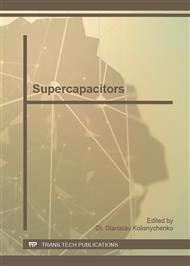p.77
p.81
p.86
p.90
p.94
p.98
p.102
p.108
p.112
Preparation and Electrochemical Characteristics of Activated Carbon Micro-Spheres for Electric Double Layer Capacitor
Abstract:
Carbon micro-spheres were obtained using β-cyclodextrin as the raw materials via hydrothermal synthesis and carbonization. The product had a perfect shape, smooth surface and narrow pore diameter distribution. The diameters were in the range of 400-700 nm. Then product was activated by ethanol and ammonium bicarbonate at low temperature in the closed system, respectively. The results showed that ammonium bicarbonate had better activation effect than ethanol. Moreover, specific surface area and pore volume of activated carbon micro-spheres reached to 1125 m2 g−1 and 0.485 mL g−1, respectively. As electrode materials of supercapacitors, the specific capacitance were improved from 154 F g−1 to 226 F g−1, increased by 46%.
Info:
Periodical:
Pages:
94-97
Citation:
Online since:
May 2011
Authors:
Price:
Сopyright:
© 2011 Trans Tech Publications Ltd. All Rights Reserved
Share:
Citation:



